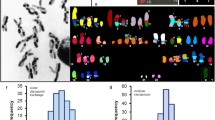Abstract
The effects of mouse satellite, main band and total DNA on the fluorescence intensity of quinacrine and of the bibenzimidazole derivative Hoechst 33258 were tested in solution. No significant differences were noticed between the double-stranded DNAs in spite of the 5% difference in AT-content between satellite and main hand DNA. Single-stranded DNAs enhanced the fluorescence intensity of Hoechst 33258 far less than double-stranded DNAs. Having been denaturated and then reassociated the DNA fractions were intermediate in their enhancing effects on the fluorescence intensity of Hoechst 33258, the differences presumably being due to different degrees of reassociation. The effect of denatured and subsequently reassociated satellite DNA on the fluorescence intensity of quinacrine was similar to that of the native DNAs. Main band and total DNA quenched the fluorescence intensity of quinacrine more after denaturation-reassociation than it did when native. In the discussion the results are related to known cytological data.
Similar content being viewed by others
References
Bostock, C. J., Christie, S.: Quinacrine fluorescence staining of chromosomes and its relationship to DNA base composition. Exp. Cell Res. 86, 157–161 (1974)
Bram, S.: Secondary structure of DNA depends on base composition. Nature (Lond.) New. Biol. 232, 174–176 (1971)
Chapelle, A. de la, Schröder, J., Selander, R.-K.: Repetitious DNA in mammalian chromosomes. Hereditas (Lund) 69, 149–153 (1971)
Chapelle, A. de la, Schröder, J., Selander, R.-K.: In situ localization and characterization of different classes of chromosomal DNA: acridine orange and quinacrine mustard fluorescence. Chromosoma (Berl.) 40, 347–360 (1973a)
Chapelle, A. de la, Schröder, J., Selander, R.-K., Stenstrand, K.: Differences in DNA composition along mammalian metaphase chromosomes. Chromosoma (Berl.) 42, 365–382 (1973b)
Comings, D. E., Avelino, E., Okada, T. A., Wyandt, H. E.: The mechanism of C- and G- banding of chromosomes. Exp. Cell Res. 77, 469–493 (1973)
Comings, D. E., Kovacs, B. W., Avelino, E., Harris, D. C.: Mechanisms of chromosome banding. V. Quinacrine banding. Chromosoma (Berl.) 50, 111–145 (1975)
Corneo, G., Ginelli, E., Soave, C., Bernardi, G.: Isolation and characterization of mouse and guinea pig satellite deoxyribonucleic acids. Biochemistry 7, 4373–4379 (1968)
Gropp, A., Hilwig, I., Seth, P. K.: Fluorescence chromosome banding patterns produced by a benzimidazole derivative. In: Chromosome identification-technique and applications in biology and medicine. Nobel Symposium 23 (T. Caspersson and L. Zech, eds.), p. 300–305. New York: Academic Press 1973
Harbers, K., Spencer, J. H.: Nucleotide clusters in deoxyribonucleic acids. Pyrimidine oligonucleotides of mouse L-cell satellite deoxyribonucleic acid and main-band deoxyribonucleic acid. Biochemistry 13, 1094–1101 (1974)
Jones, K. W.: Chromosomal and nuclear location of mouse satellite DNA in individual cells. Nature (Lond.) 225, 912–915 (1970)
Jones, K. W., Corneo, G.: Location of satellite and homogeneous DNA sequences on human chromosomes. Nature (Lond.) New Biol. 233, 268–271 (1971)
Jones, K. W., Prosser, J., Corneo, G., Ginelli, E.: The chromosomal location of human satellite DNA. III. Chromosoma (Berl.) 42, 445–451 (1973)
Kurnit, D. M.: DNA helical content during the C-banding procedure. Cytogenet. Cell Genet. 13, 313–329 (1974)
Latt, S. A.: Microfluorimetric detection of deoxyribonucleic acid replication in human metaphase chromosomes. Proc. nat. Acad. Sci. (Wash.) 70, 3395–3399 (1973)
Latt, S. A., Brodie, S., Munroe, S. H.: Optical studies of complexes of quinacrine with DNA and chromatin: implications for the fluorescence of cytological chromosome preparations. Chromosoma (Berl.) 49, 17–40 (1974)
Marmur, J.: A procedure for the isolation of deoxyribonucleic acid from micro-organisms. J. molec. Biol. 3, 208–218 (1961)
McIlvaine, T. C.: A buffer solution for colorimetric comparison. J. biol. Chem. 49, 183–186 (1921)
Pachmann, U., Rigler, R.: Quantum yield of acridines interacting with DNA of defined base sequence. Exp. Cell Res. 72, 602–608 (1972)
Raposa, T., Natarajan, A. T.: Fluorescence banding pattern of human and mouse chromosomes with a benzimidazol derivative (Hoechst 33258). Humangenetik 21, 221–226 (1974)
Schnedl, W.: The karyotype of the mouse. Chromosoma (Berl.) 35, 111–116 (1971)
Schreck, R. R., Erlanger, B. F., Miller, O. J.: The use of antinucleoside antibodies to probe the organization of chromosomes denatured by ultraviolet irradiation. Exp. Cell Res. 88, 31–39 (1974)
Selander, R.-K., Chapelle, A. de la: The fluorescence of quinacrine mustard with nucleic acids. Nature (Lond.) New Biol. 245, 240–244 (1973)
Southern, E. M.: Base sequence and evolution of guinea pig α-satellite DNA. Nature (Lond.) 227, 794–798 (1970)
Stockert, J. C., Lisanti, J. A.: Acridine-orange differential fluorescence of fast and slow reassociating chromosomal DNA after in situ DNA denaturation and reassociation. Chromosoma (Berl.) 37, 117–130 (1972)
Weisblum, B.: Fluorescent probes of chromosomal DNA structure: three classes of acridines. Cold Spr. Harb. Symp. quant. Biol. 37, 441–449 (1973a)
Weisblum, B.: Why centric regions of quinacrine-treated mouse chromosomes show diminished fluorescence. Nature (Lond.) 246, 150–151 (1973b)
Weisblum, B., Haseth, P. de: Quinacrine, a chromosome stain specific for deoxyadenylatedeoxythymidylate-rich regions in DNA. Proc. nat. Acad. Sci. (Wash.) 69, 629–632 (1972)
Weisblum, B., Haenssler, E.: Fluorometric properties of the bibenzimidazole derivative Hoechst 33258, a fluorescent probe specific for AT concentration in chromosomal DNA. Chromosoma (Berl.) 46, 255–260 (1974)
Author information
Authors and Affiliations
Rights and permissions
About this article
Cite this article
Simola, K., Selander, RK., de la Chapelle, A. et al. Molecular basis of chromosome banding. Chromosoma 51, 199–205 (1975). https://doi.org/10.1007/BF00284814
Received:
Accepted:
Issue Date:
DOI: https://doi.org/10.1007/BF00284814




